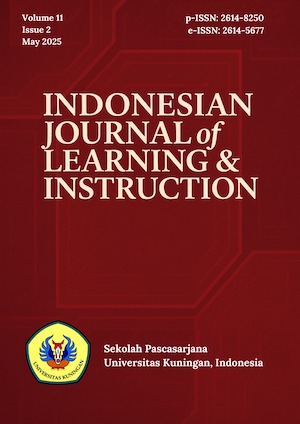COMPUTER TEACHERS’ AWARENESS OF VIRTUAL REALITY FOR INSTRUCTIONAL PURPOSE IN KWARA STATE
Abstract
Virtual reality is an emerging technology designed to provide interaction between a user and artificially generated environments. However, most teachers in Nigeria are not aware of how virtual reality can be widely used for educational purposes. The study investigated (i) awareness of teachers towards the use of virtual reality for instructional purpose and influence of gender and experience on teachers’ awareness of virtual reality for instructional purpose. Descriptive survey research design was adopted for this study. 360 computer teachers were sampled from secondary schools across Kwara State with the use of researchs-developed questionnaire. The findings established that Virtual Bicycle and 3D Map world are the virtual reality facilities which most respondents are of aware for instructional purpose; and there was no significant difference between teachers’ awareness of VR for instructional purpose based on gender and experience. It was thus recommended that seminars and training could also be organised for teachers on how to use VR to facilitate their teaching in and outside the classroom environment.
Keywords: awareness; computer teachers; virtual reality; gender; experience; instructional purposes.
References
Abdullahi, Z. O. (2020). Determinants of Virtual Labs Adoption Among Physics Teachers in Ilorin-West Local Government Area. Dissertation, Department of Educational Technology, University of Ilorin, Ilorin, Nigeria.
Adekomi, U. Y. (2014). Improving Computer Science Education. 1st Edition., Routledge Chapman and Hall, London.
Anaza, A. O. (2017). Assessment of lecturers’ attitudes toward mobile technology usage for instruction in colleges of education in North Central, Nigeria. conference proceedings Association for Innovative Technology in Education (AITIE 2017), 67-74. Ilorin: Association for Innovative Technology in Education.
Ausburn, L. J., & Ausburn, F. B. (2014). Desktop virtual reality: A powerful new technology for teaching and research in industrial teacher education. Journal of Industrial Teacher Education, 41(4), 33-58.
Bahar, M., & Asil, M. (2018). Attitude towards e-assessment: influence of gender, computer usage and level of education. Open Learning: The Journal of Open, Distance and e-Learning, 33(3), 221-237.
Bain, C. D., & Rice, M. L. (2013). The Influence of Gender on Attitudes, Perception, and use of Technology. Journal of Research on Technology in Education, 39(2), 119-132.
Bhattacharya, I., & Sharma, K. (2017). India in the knowledge economy: An electronic paradigm. International Journal of Educational Management, 21(6), 543–568.
Bridget, E. U., & Comfort, U. (2016). Enhancing the utilization of information communication technology (ICT) among home economics lecturers in South Eastern Nigeria. Journal of Education and Practice, 7 (9), 34-39.
Cuadrado-García, M., Ruiz-Molina, M. E., & Montoro-Pons, J. D. (2018). Are there gender differences in e-learning use and assessment? Evidence from an interuniversity online project in Europe. Procedia-Social and Behavioral Sciences, 2(2), 367-371.
Dede, C., Salzman, M. C. & Loftin, R. B. (2013). Science Space: Virtual Realities for Learning Complex and Abstract Scientific Concepts. In Proceedings of IEEE Virtual Reality Annual International Symposium, 246-253. Retrieved from http://www.vetl.uh.edu/Science-Space/absvir.html
Ebrahimi, S. S., & Jiar, Y. K. (2018). The Use of Technology at Malaysian Public High Schools. Merit Research Journal of Education and Review, 6(3), 54-60.
Enoch, Y., & Soker, Z. (2016). Age, gender, ethnicity and the digital divide: University students’ use of web-based instruction. Open Learning, 21(2), 99-110. doi:10.1080/02680510600713045.
Federal Republic of Nigeria (2014). National Policy on Education. Lagos: NERDC Press
Garrison, D. R. (2017). Online Community of Inquiry Review: Social, cognitive, and teaching presence issues. Journal of Asynchronous Learning Networks, 11(1), 61-72.
Idrus, H., & Salleh, R. (2017). Perceived self-efficacy of Malaysian ESL engineering and technology students on their speaking ability and its pedagogical implications. The English Teacher, XXXVII, 61-75.
Kaur, N. (2015). Using ICT in empowering teachers for quality education. International Journal of Scientific Research Engineering and Technology, 2(3), 8-12.
Leach, L., & Turner, S. (2015). Computer users do gender: The co-production of gender and communications technology. Sage Open, 5(4), 51-58. doi.org/10.1/2158244015604693.
Lee, E. A., & Wong, K. W., & Fung, C. C. (2016). How does desktop Virtual Reality Enhance Learning Outcomes? A structural equation modeling approach. Computers & Education, 55, 1424–1442.
Lorenzo, G. L., Biesanz, J. C., & Human, L. J. (2019). What is beautiful is good and more accurately understood. Physical attractiveness and accuracy in first impressions of personality. Psychological Science, 21(12), 1777–1782. Retrieved from http://doi.org/10.1177/0956797610388048.
Mahdi, H. S., & Al-Dera, A. S. (2013). The Impact of Teachers’ Age, Gender and Experience on the Use of Information and Communication Technology in EFL Teaching. English Language Teaching, 6(6), 57-67. Retrieved from http://www.ccse-net.org/journal/index.php/elt/article/viewFile/27261/16554.
Mahmood, F., Halim, H. A., Rajindra, S. & Ghani, M. M. (2014) Factors affecting teachers' utilization of technology in Malaysian ESL classrooms. The Malaysian Online Journal of Educational Technology. 2(2), 15-23.
Msagati, N. (2014). Awareness and use of scholarly electronic journal by members of academic staff: A case study of Der es Salaam university college of education. Library Philosophy and Practice (e-journal).1124, 1-25.
Nam, C., & Smith-Jackson, T. (2017). Web-based learning environment: A theory-based design process for development and evaluation. Journal of Information Technology Education: Research, 6(1), 23-43.
Nwokedi, V. C. & Nwokedi, G. I. (2017). Assessment on use of search engines by lecturers in the Faculty of Medical Sciences, university of Jos, Nigeria. Journal of Applied Information Science and Technology, 10(2), 23-32.
Ogunlade, O. O., Olafare, F. O., & Udom, S. O. (2013). Perception of undergraduates on the role of information and communication technology in intrapreneurial education in University of Ilorin, Nigeria. The of Education in Developing Area, 21 (1), 117-123.
Prensky, S. (2015). Promoting teaching and learning in Ghanaian Basic Schools through ICT. International Journal of Education and Development using ICT, 11(2), 256-263.
Pujari, R. L. (2017). Usage of search engines among women post-graduation students: A case study of Karnataka State Women’s University Bijpaur. Proceedings of 72nd ISERD International Conference, Bangkok, Thailand. 1-4.
Punter, R. A., Meelissen, M. R. M., & Glas, C. A. W. (2016). Gender differences in computer and information literacy: An exploration of the performances of girls and boys in ICILS. European Educational Research Journal, 1(1), 1–19. doi:10.1177/1474904116672468.
Rajasekhar, P., Veena, C. N. & Kumar, S. (2018). Gender differences in Internet preferences and usage pattern among medical students. National Journal of Physiology, Pharmacy and Pharmacology, 8(5), 683-686.
Sawchuk, S. (2015). New Studies Find That, for Teachers, Experience Really Does Matter. Retrieved from Education Week: http://www.ed-week.org/ew/articles/2015/03/25 /new-studies-find-that-for-teachers-experience.html.
Soetan, A. K., Onojah, A. O., Alaka, T. B., & Aderogba, A. J. (2020). Hearing Impaired Students’ Self-Efficacy on The Utilization of Assistive Technology in Federal College of Education (Special) Oyo. International Journal for Cross-Disciplinary Subjects in Education, IJCDSE, 11(1), 4245-4252. doi: 10.20533/ijcdse.2042.6364.2020.0519
United Nation. (2014). Measuring ICT and gender: An assessment. United Nation: United Nations Publication.
Usang, A. I., Archibong, D. O., Aji, E. E., Eyong, C., Ukam, E., & Bassey, O. A. (2018). Assessment of influence of student perception, knowledge and area of specialization on ITC utilization for academic purposes in colleges of health technology, Calabar. International Journal of Medicine and Medical Science, 10 (3), 36-41.
Van Braak, J. (2019). Factors Influencing The Use of Computer Mediated Communication by Teachers in Secondary Schools. Computers & Education, 36, 41-57.
Vlastimir N., & Dalibor P., (2019). Appraisal and review of e-learning and ICT systems in teaching Process in Physica A. Statistical mechanics and its Application 513(1), 456-464.









